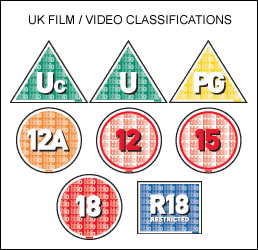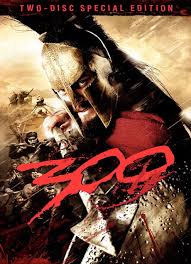Learning Objective: To understand the purpose of film certification and to apply my understanding to my own thriller film.
Film Certification is a film rating system that is designated to classify films with regard to suitability for audiences in terms of issues such as sex, violence, substance abuse, profanity, impudence or other types of mature content.
If a film is particularly suitable for a pre-school child to view alone, this will be indicated in the Consumer Advice.
The ‘12A’ category exists only for cinema films. No one younger than 12 may see a ‘12A’ film in a cinema unless accompanied by an adult and films classified ‘12A’ are not recommended for a child below 12. An adult may take a younger child if, in their judgement, the film is suitable for that particular child. In such circumstances, responsibility for allowing a child under 12 to view lies with the accompanying adult.
No one younger than 15 are authorised watch a 15 rated film in a cinema. No one younger than 15 may rent or buy a 15 rated video for example video tape.
18: Suitable for persons over the age of 18-
No one younger than 18 are authorised to watch an 18 rated film in a cinema. No one younger than 18 may rent or buy an 18 rated video for example DVD.
There are many cases of film censorship in terms of cuts every year, whilst most are violent films such as Terminator 2 Judgement Day. The producers make uncut versions and full versions by cutting out disturbing shots from scenes and making to DVD discs of separate with different features.
British board of film Classification
The British board of film classification also known as BBFC is responsible for the film classification of with the United Kingdom, they also have the responsibility of rating videos, DVDs and video games under the recording act of 2010. Legal authorities have the power to rate films and show them in the cinema but almost always follow the advice of the BBFC.
All films and videos games rated by the BBFC are given a certificate along with details about the film or video game recting information about it for example sex, violence and drugs. If a certificate of a film or video game that shows a age rating of 15 for example only that person or somebody older can purchase the item.
The BBFC use symbols to identify the age certificate of the film towards the audience for example "U", this makes the audience aware of what age rating film they are watching and wish to purchase.
Film Certification
 |
U: Universal, Suitable for all-
It is impossible to predict what might upset any particular child. But a ‘U’ film should be suitable for audiences aged four years and over. ‘U’ films should be set within a positive moral framework and should offer reassuring counterbalances to any violence, threat or horror.
 |
'Rugrats run riot' is a purely good example of a U rating as it appeals to all audiences by being funny and having comedy content but mainly it appeals to children as it shows the life of 8 babies and their adventures around adults.
PG: Parental Guidance Recommended,-
General viewing, but some scenes may be unsuitable for young children.
Children of any age may watch this alone. A ‘PG’ film should not disturb a child aged around eight or older. However, parents are advised to consider whether the content may upset younger or more sensitive children.
An example of a PG rating would be 'Antz' as it shows mild language and menacing action. The mild language is used by adults ants to prove a point. For those sensitive to swearing, there will be more swear words than you might expect for a PG movie. The ants are seen as food to other insects. Also, they may be stepped on by people. However, the most menacing action occurs during a full scale war with a termite colony. The large termites eating the ants are pretty frightening images. The dialogue is often directed at adults. However, the story line seemed more in keeping with a children's story
12A, 12: Suitable for persons over the age of 12-
Exactly the same criteria are used to classify works at ‘12A’ and ‘12’. These categories are awarded where the material is suitable, in general, only for those aged 12 and over. Works classified at these categories may upset children under 12 or contain material which many parents will find unsuitable for them.
 |
The ‘12’ category exists only for video works. No one younger than 12 may rent or buy a ‘12’ rated video work.
An example of a 12 rated film is 'Ace Ventura: Pet Detective' as it contains a lot and ongoing moderate language used in a comedy fashion to attract an older audience to this teenager based film as it shows moderate violence that is not long going but also brief nudity and imitable behaviour which is seen but no through out the film.
15: Suitable for persons over the age 15-
 |
'Pineapple Express' is good example of a 15 rated film as it contains mostly all the content of a 15 rated film by containg strong violence, mild drug use, frequent strong language, and portrays of sexual activity.
18: Suitable for persons over the age of 18-
 |
An example of a strong 18 rated film would be 'Crank' as it shows strong and menacing violence and murder from the start, drug use, strong language, racial content, discrimination and strong sex content.
R18: To be shown only in specially licensed cinemas, or supplied only in licensed sex shops, and to adults of not less than 18 years-
The ‘R18’ category is a special and legally restricted classification primarily for explicit works of consenting sex or strong fetish material involving adults. Films may only be shown to adults in specially licensed cinemas, and video works may be supplied to adults only in licensed sex shops. ‘R18’ videos may not be supplied by mail order.
Censored films of the 90s
 |
British board of film Classification
 |
All films and videos games rated by the BBFC are given a certificate along with details about the film or video game recting information about it for example sex, violence and drugs. If a certificate of a film or video game that shows a age rating of 15 for example only that person or somebody older can purchase the item.
The BBFC use symbols to identify the age certificate of the film towards the audience for example "U", this makes the audience aware of what age rating film they are watching and wish to purchase.























